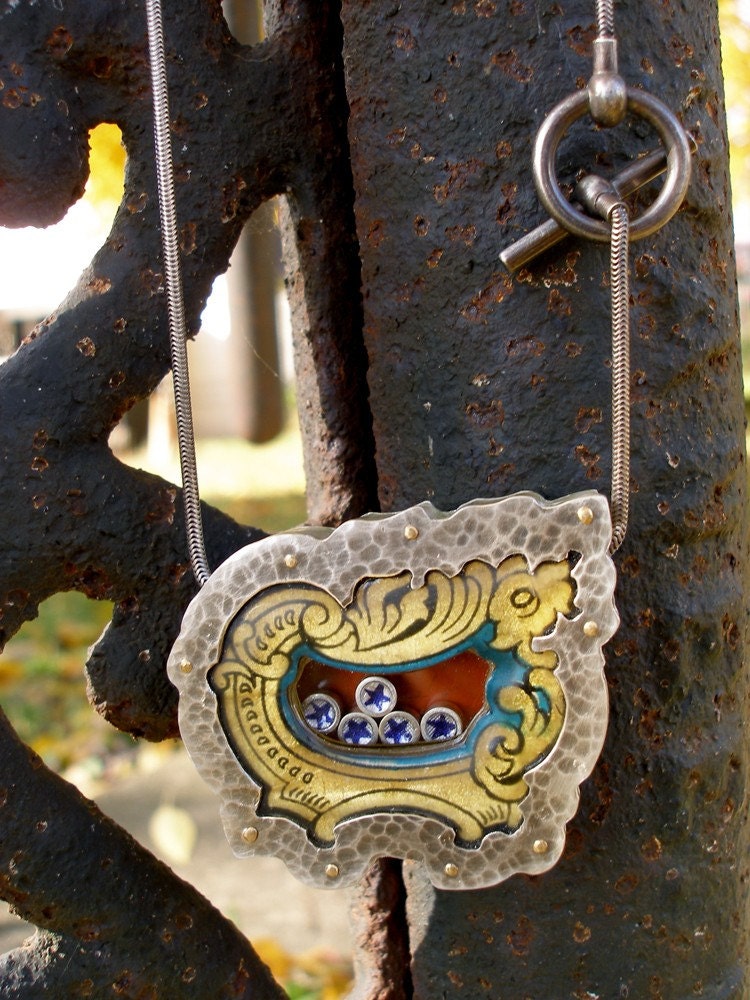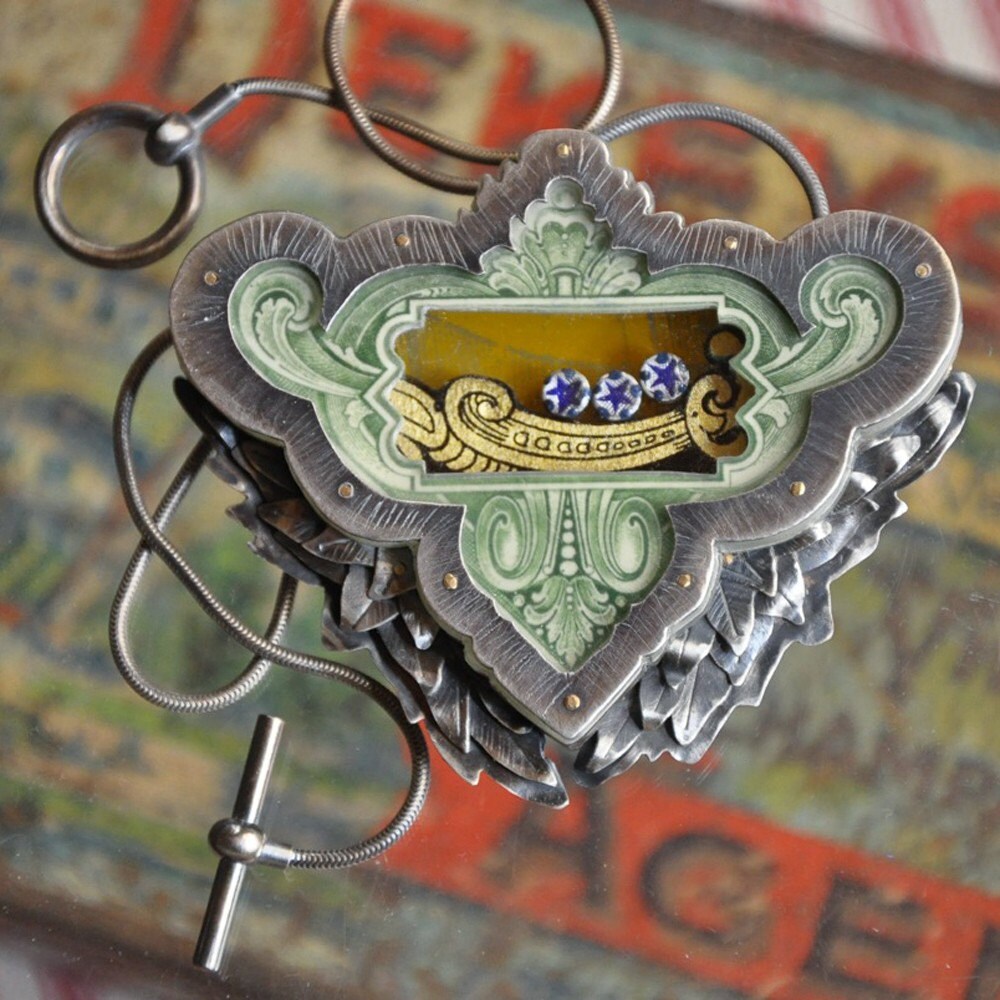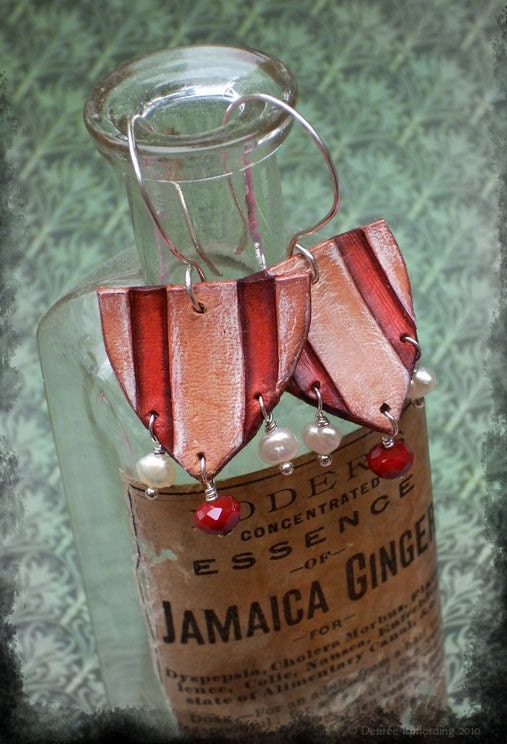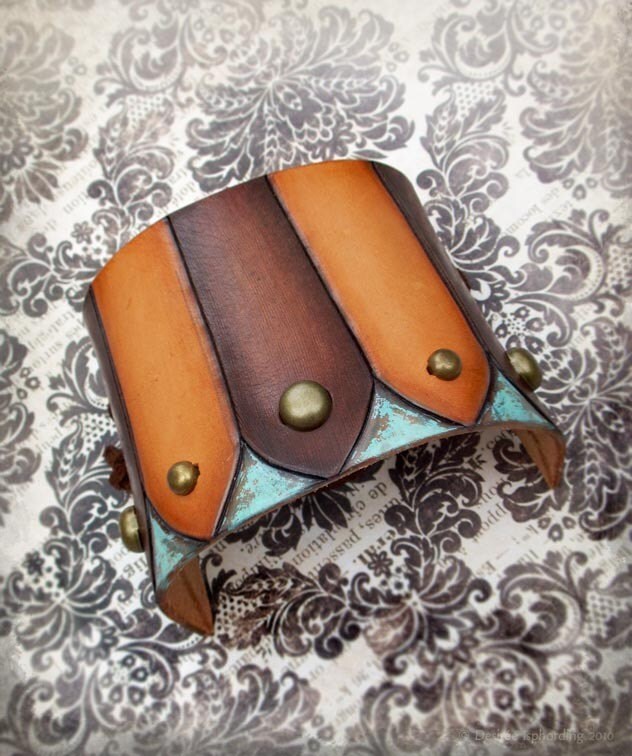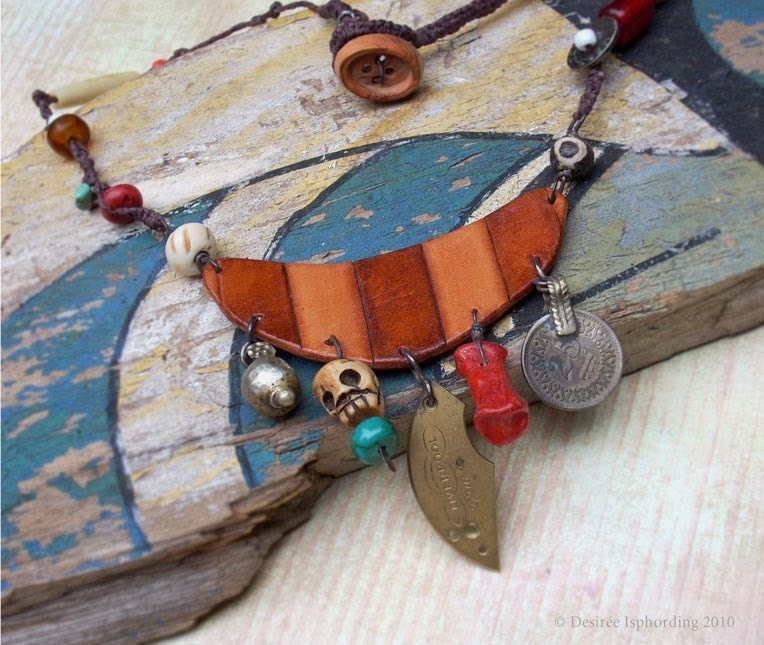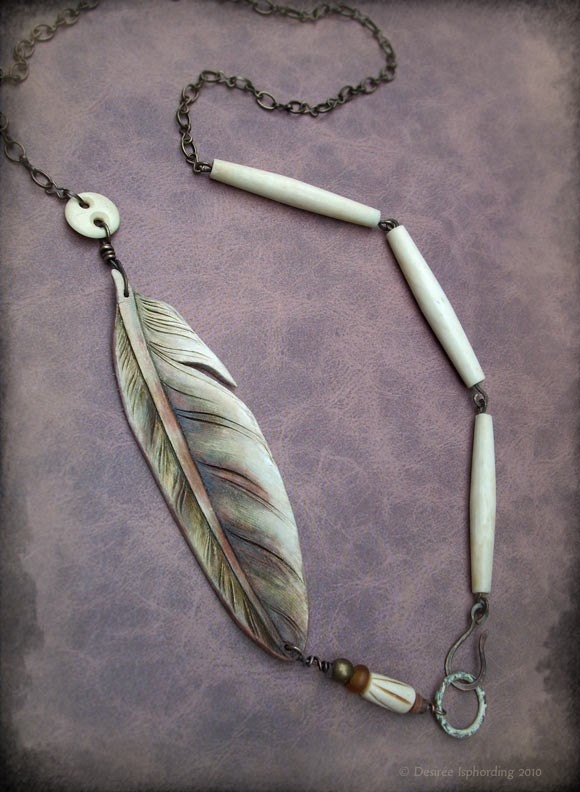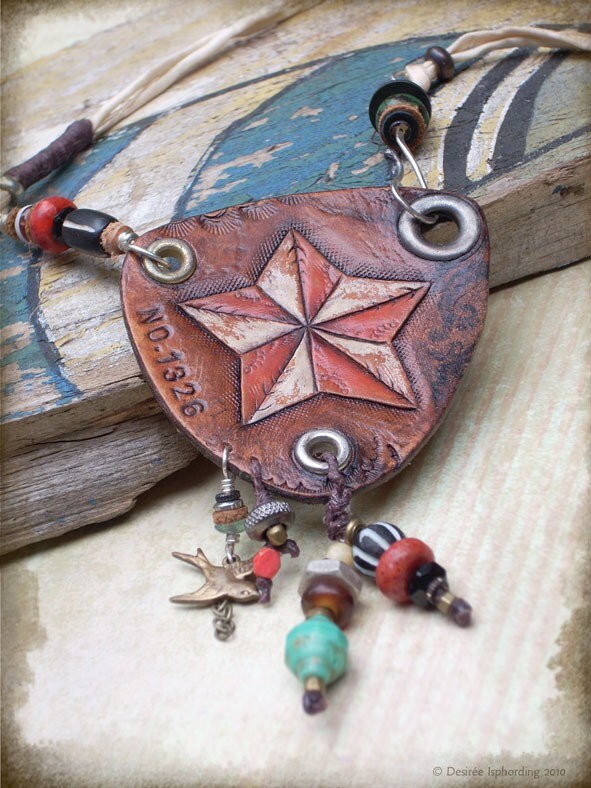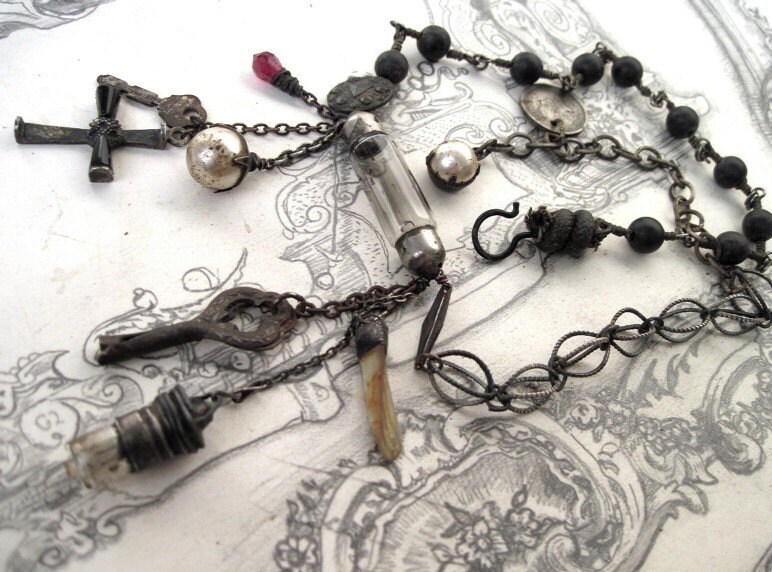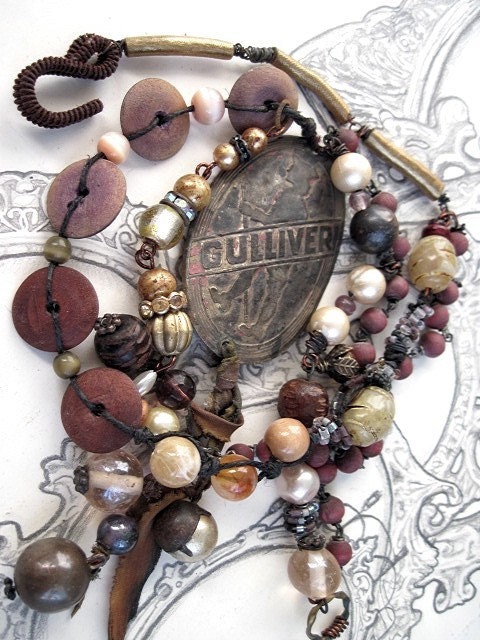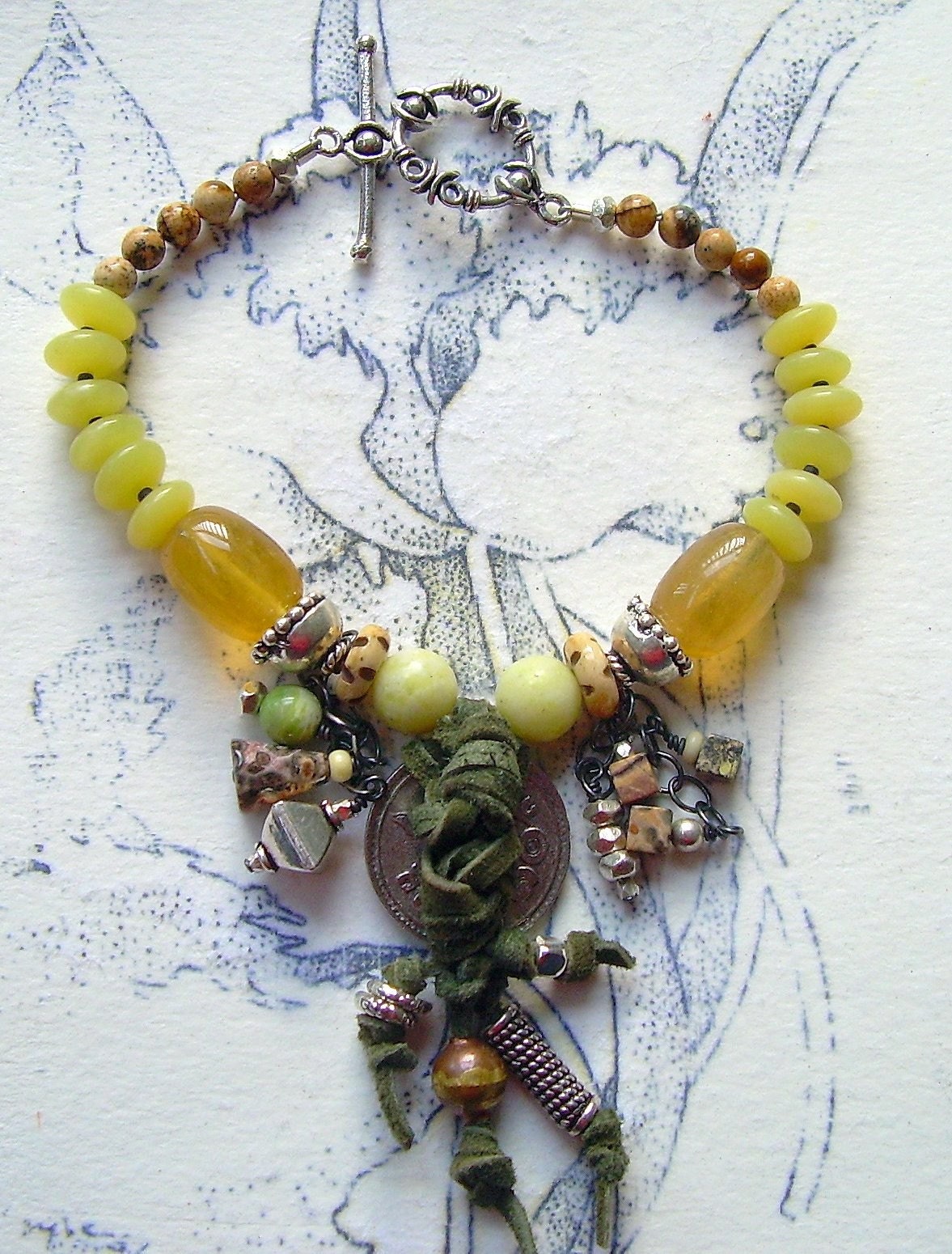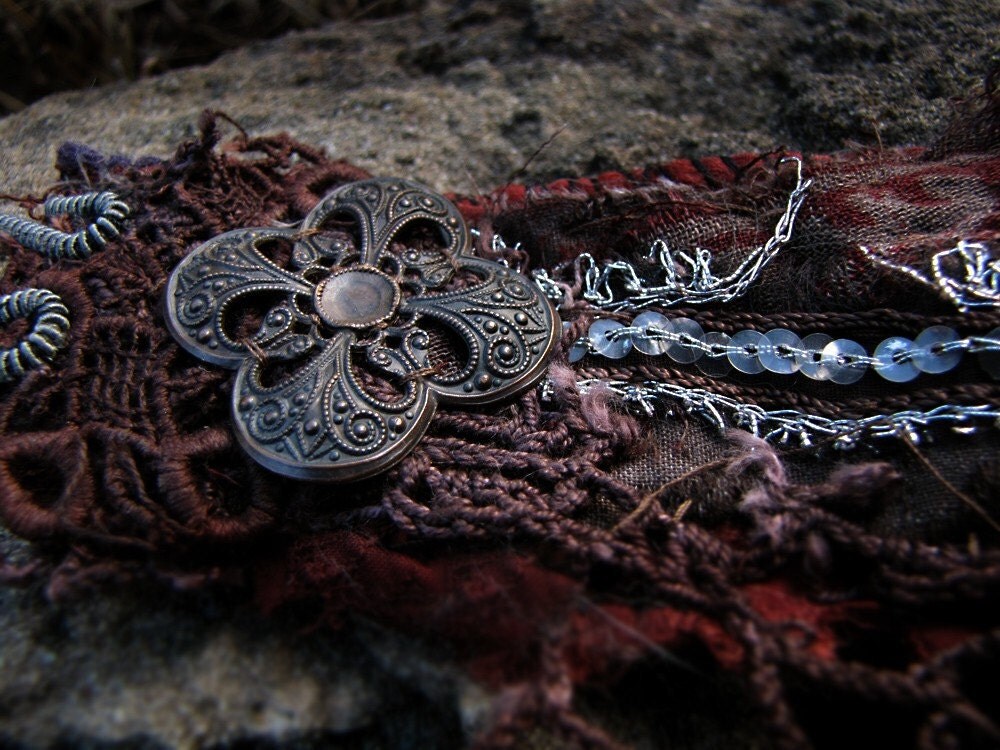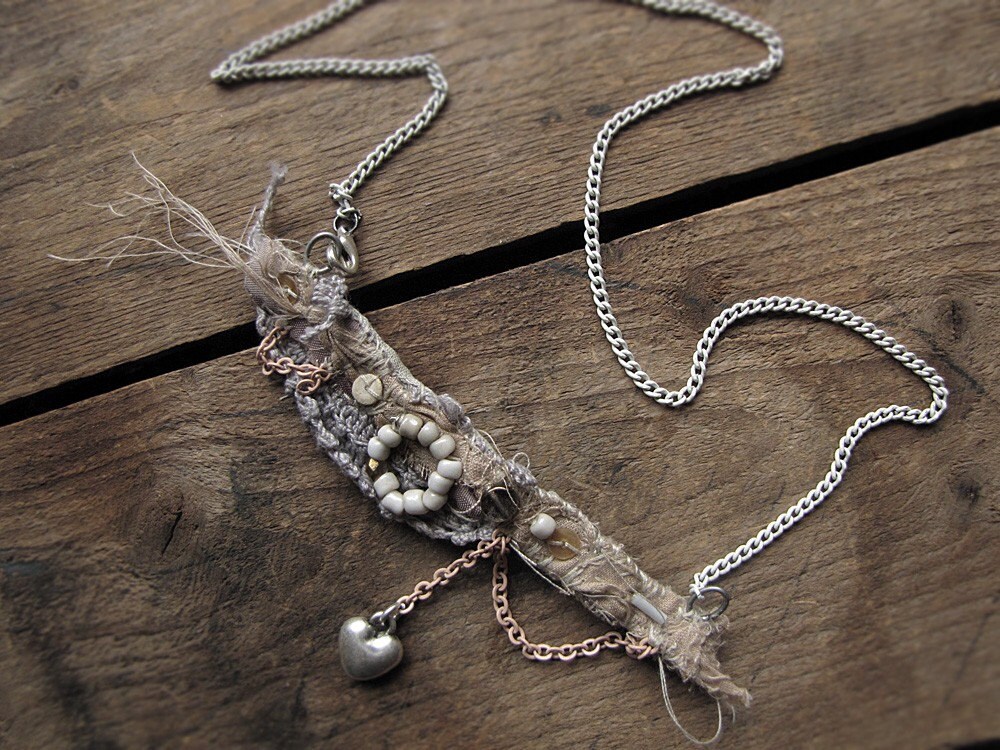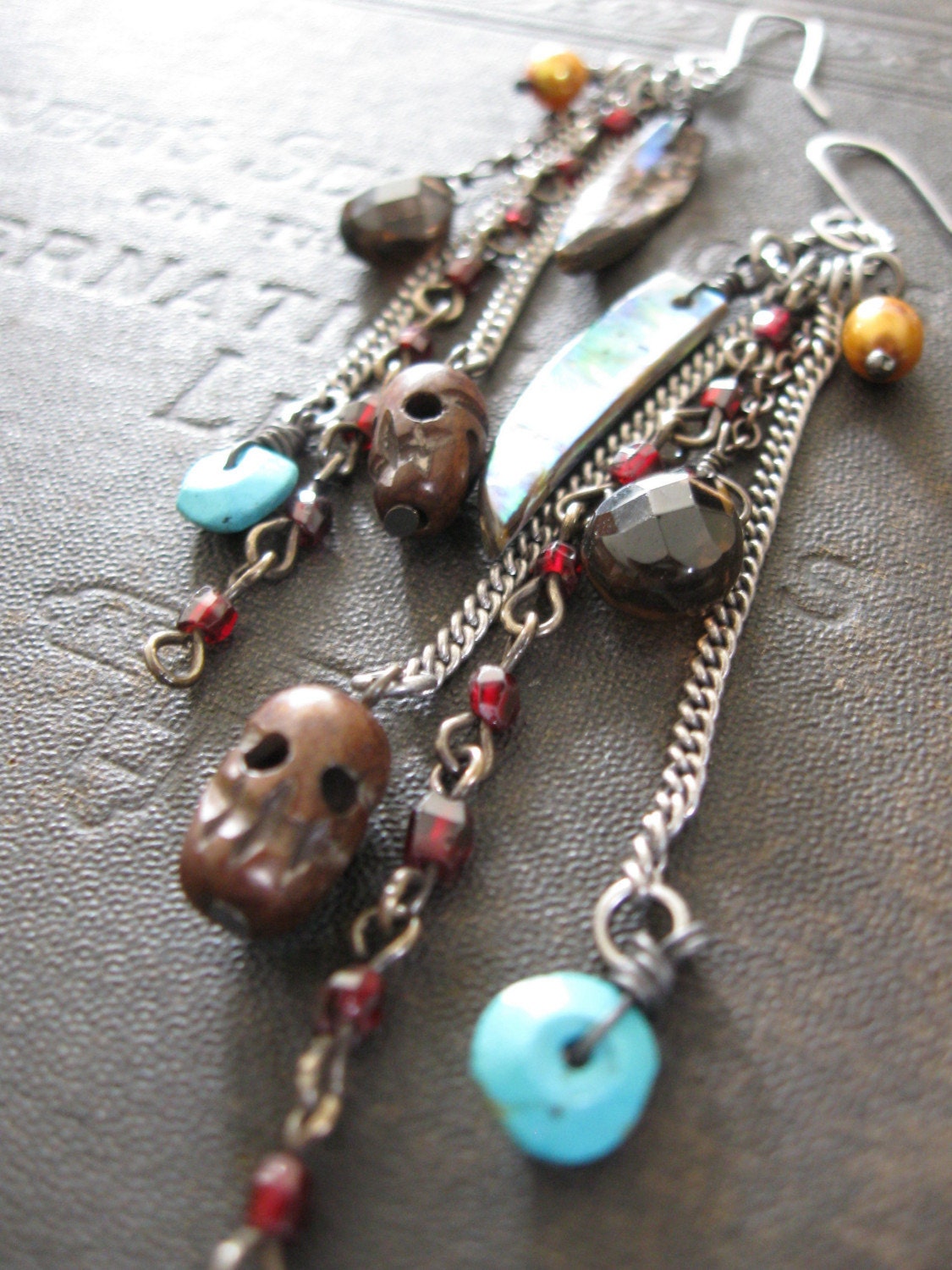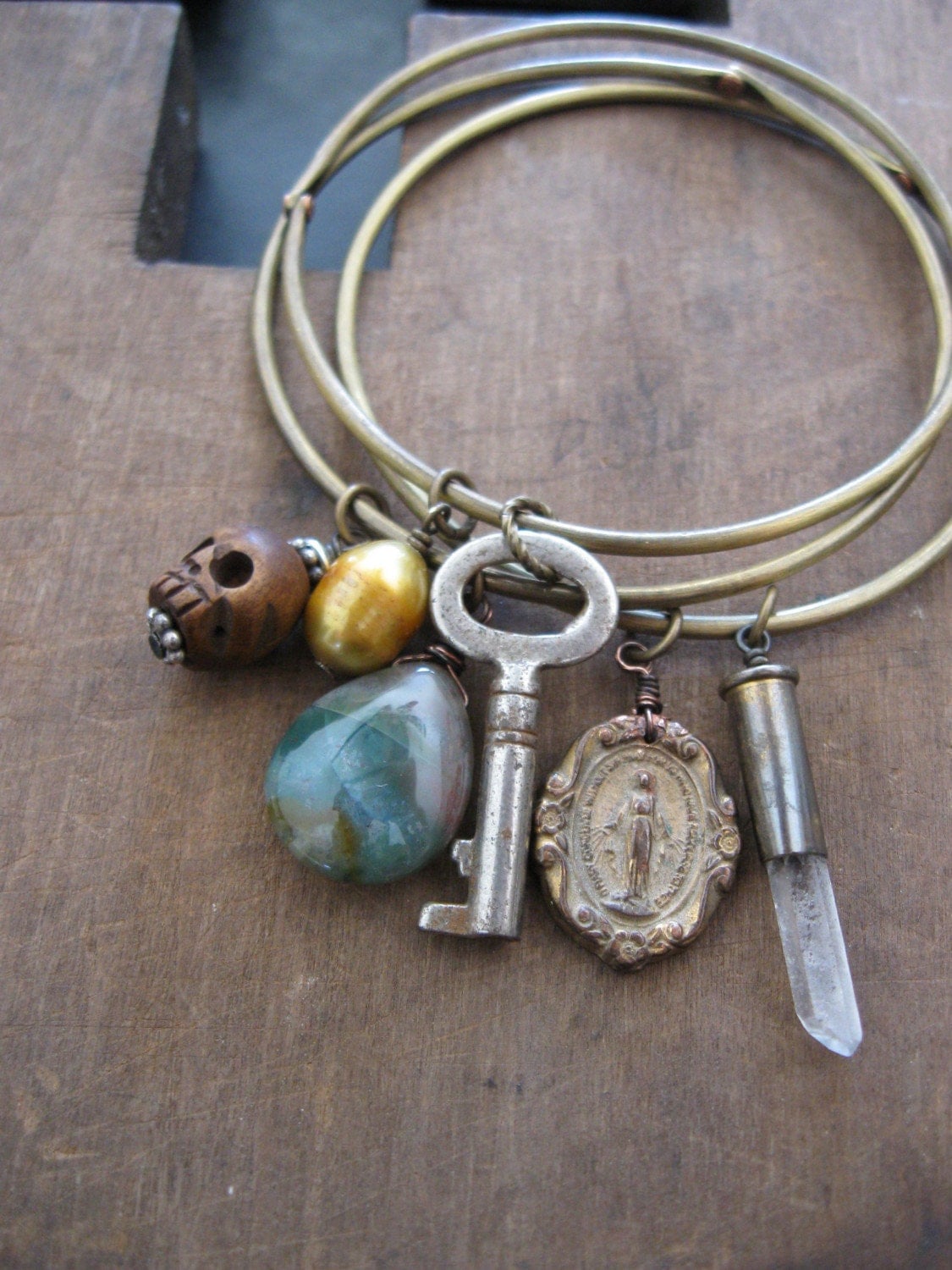
My grandfather & I riding the Prince Charming Regal Carrousel (formerly called Cinderella's Golden Carrousel) in Walt Disney World which was the Philadelphia Toboggan Company's 46th machine. Photo circa 1989.
I've been enchanted by carousels since I was very young. My family and I used to attend annual holiday parties at my great aunt's house and I always looked forward to visiting her home so I could engross myself in her copy of
Painted Ponies. My parents eventually purchased the book for me as a Christmas present which really set my obsession into motion. I would bring along my camera to every amusement park we went to in order to document the merry-go-rounds therein, and carousel animals populated my artwork for several years (there is a precedent for all of my recent carnival-themed jewelry!). I attended the
ceremonies at the Carousel World Museum in Lahaska, PA (unfortunately now defunct) when the US Postal Service premiered its series of four carousel-themed stamps in 1995. The subject of my first research paper, assigned during the last year of elementary school supposedly to prepare us for the rigors of middle school ahead, was carousel art. This also coincided with the time period where the local Alan Herschell Company machine, the
Perkasie Carousel, was undergoing restoration. I wanted so badly to assist in the re-painting of the aluminum horses and volunteered for it, but unfortunately I was not asked to participate. I did get to help with raising some funds for it at my school though which was some consolation. My obsession faded a year or so after that, but I still greatly appreciate antique, hand-carved carousels for the supreme examples of art and craft that they are. Towards the end of the Spring 2006 semester of my college studies I was struggling to determine a final essay topic for a class on the history of American craft. It dawned on me that my youthful obsession could prove of great use and the essay below was born. I hope that you enjoy it and the photos accompanying it.
Throughout the history of their creation, the lively figures of the American carousel have been embodiments of art, craft, and design. Even though during their production and in the heyday of their use they may have been largely viewed as whimsical elements contributing to the overall amusement experience provided by the carousel, it would be difficult to deny that carousel animals are indeed works of craftsmanship, artistry, and considered design. Although such delightful diversions as carousels are often ignored by art and craft historians, they can reveal as much about the overall culture and history of their respective time periods as the fine arts, crafts, architecture, etc. created during the same periods.
The carousel has its ultimate roots in feats of horsemanship and displays of martial skill. In fact, the modern word carousel “derives from the ancient Italian and Spanish words
garasello and
carosella meaning ‘little war’” (Fried 18). While in Arabia and Turkey, European crusaders observed a game where men on horseback were engaged in throwing and catching small clay balls filled with perfumed water. If one of the contestants happened to miss his catch, he would be saturated with the liquid and clearly marked as defeated. Once this concept was brought back to Europe, it evolved into elaborate tournaments staged by the French monarchy with each horse and rider decadently costumed for the occasion. The Place du Carousel in Paris still bears the name of the extravagant pageant held there by Louis XIV in 1662. Eventually, clay balls were replaced with metal rings and lances. The object became not to simply catch a ball while riding, but to manage a long lance and hopefully to spear a ring suspended from a tree or two posts while riding. According to Fried, “in France about 1680, the carousel became mechanical. Someone thought of suspending horses and chariots by chains from arms radiating from a center pole” (19). Powered by man, horse, or mule, this device was intended as a training tool for those who sought to hone their lancing skills. While the structure turned, an individual on their dangling horse would attempt to spear a stationary ring positioned near the periphery of the spinning contraption. This strange device ended up becoming popular not only as a means to improve one’s lancing aptitude, but for entertainment purposes as well. In the 1830’s a new method appeared which replaced the former technique in which a person or horse manually turned the center pole. This new method utilized gears so that the pole could be turned by a crank. However, the mayor revolution in carousel propulsion occurred when an Englishman named Frederick Savage decided to enlist the steam engine to turn an all-bicycle carousel in 1866 (Fraley 22). Savage is also responsible for developing a system of overhead gears which produce the classic up-and-down galloping motion used on carousels until the present day.
The carousel flourished throughout Europe, and it was only a matter of time before it spread across the Atlantic. The exact date of the appearance of the first carousel in America in unknown. While it has been typically thought that the first American-made carousel was crafted in 1878, there is evidence of carousels in the United States as early as 1825 (Fried 51). According to Anne Dion Hinds though, this date could be pushed even further back in time. She states that “primitive carousels must have been around earlier than 1784: that year New York City Common Council passed a law banning them as dangerous” (40). However, even though stream-driven roundabouts had been enamoring Europe since the 1830s, it would take another fifteen years before steam engines powered their American counterparts.

This is an outside row stander from the carousel formerly operating at Carousel World Museum in Lahaska, PA. This carousel featured a mix of animals carved by different makers. I believe this horse in particular was carved by Charles Carmel. The museum closed several years ago and a different carousel featuring
hand-carved replicas of classic animals now operates in this location which is now known as
Giggleberry Fair.
When Gustav A. Dentzel built his first American carousel in 1867, it was a simple construction: a series of wooden benches hung by chains from radial sweeps. It wasn’t powered by steam, or even by a horse, but by Dentzel himself. Gustav arrived in Philadelphia, Pennsylvania from Germany in 1860 and set up shop as a cabinet-maker, but carousels were in his blood; his father Michael Dentzel had built and operated several of them back in Germany. A decade later, not only did Dentzel establish his own carousel-building company in Philadelphia, but others were established by Charles Looff and Charles Dare in New York City, and by James Armitage and Allan Herschell in North Tonawanda, New York. The efforts of these early American carousel builders among others produced some of the noteworthy, longest-lived companies.
Three basic styles began to emerge during this time period: The Coney Island Style, the Country Fair Style, and the Philadelphia Style. The Philadelphia Style, exemplified by such companies as D.C. Muller and Bro., the Philadelphia Toboggan Company, and of course Dentzel’s own, is characterized by its “dignified realism” (Hinds 10). The Coney Island Style, named after the famous New York amusement hub which once hosted more than 20 simultaneously operating carousels in its heyday, is characterized by its more fanciful, flashy expressions and ornamentations. Coney Island style animals are often bedecked with gold-leaf manes, their trappings set with small mirrors and glass jewels. Companies and carvers associated with this particular style include M.C. Illions, Charles Looff, Charles Carmel, and Stein and Goldstein. By contrast with the Coney Island and Philadelphia styles and their preoccupation with highly detailed, sophisticated figures, the Country Fair Style is much more simple and less finely-rendered, and for good reason. While most companies producing Philadelphia and Coney Island style carousels were primarily creating so-called stationary or park machines, Country Fair Style companies including those of Herschell/Spillman, Charles Dare, and Charles Parker typically produced portable machines. Excessive ornamentation and delicate features are easily damaged and worn by frequent disassembly, travel, and reassembly. Therefore, many Country Fair style animals have basic trappings and decorations as well as a more rustic charm.
Depending upon who one asks, the “Golden Age of the Carousel” in the United States can be said to span a period from approximately 1880 to 1930 (Hinds 3). The statistics regarding the number of carousels produced during that time period also tends to vary based upon sources, and due to the lack of records, the exact numbers may never be known. For instance, one source states that “of more than 4,000 hand-carved wooden carousels built between 1900 and 1925, fewer than 170 survive”(Carousel Art). Although the statistics may vary, they all reveal the same basic truth: there has been a staggering loss in the number of the nation’s operating antique carousels. Traditional, wooden carousels, once a common sight throughout America in locales both rural and urban, are now an endangered species. The story of the rise, fall, and rebirth of the carousel in the US is deeply tied to the historical, cultural, and technological changes that affected its populous.

A close-up of one of the outside row jumpers from the aforementioned PTC machine at Walt Disney World. I believe this particular horse, along with many of the other more ornate horses on this carousel, was carved by John Zalar.
The real blossoming of the carousel’s golden age can be attributed to transitions brought about by the widespread application of new technology. The industrial revolution was gaining speed, bringing with it time-saving labor devices, electricity, and faster methods of transportation. These elements combined to initiate a phenomenon people today often take for granted — the weekend. Trolley companies, seeking to boost their profits on those days of less traffic, decided to devise an impetus for people to ride the trolleys in their newfound leisure time. That clever invention came to be known as the trolley park, a generally suburban or rural station at the end of the trolley line which acted as a destination of rest, relaxation, and amusement. The centerpieces of these newfangled parks were often carousels. The trolley park turned out to be a success, and as new parks were built, there was more demand for carousels to occupy them. With the growing popularity of carousels, competition between companies increased. Each company sought to outdo one another with the beauty of their carousels, and during this time period trappings became quite ornate. Another result of the carousel boom was that individual carvers decided to break away from their respective companies and forge ahead on their own.
Unfortunately, the golden age was not to last. More novel advances, such as movie theaters, radio, and the automobile began to lead people elsewhere, away from trolley parks and small amusement venues. World War I had a devastating effect, bringing the carousel industry to a standstill, and while business improved somewhat in the 1920s, the carousel would never again reach its former zenith. The carousel was once viewed as an exciting thrill ride, but by this time there were other rides and pastimes that usurped that position, the carousel was now perceived as a romantic vision of a bygone era. The people who were interested in purchasing new merry-go-rounds during this period in history were no longer interested in having a dazzling jewel of a carousel, instead they sought less expensive, basic machines whose ultimate purpose was to turn a profit. While some carousels were still hand-carved, the new desire for cost-effectiveness began to phase out individual carvers in favor of wholly machine-made figures. It would seem that the final blow that caused the demise of the golden age of the carousel was the great Depression, which forced many of the major companies to go out of business. 1930 marks the year of the creation of the last fully wooden carousel (Hinds 47). After the second World War, carousels became regarded as too decadent for the stringent budgets of the time, and were essentially abandoned. Scores of parks were compelled to close their doors forever: “the number of amusement parks has shrunk from a peak of about 1,500 in the 1920s to fewer than 200 major parks, including about two dozen large theme parks, in the 1980s. Fewer than sixty amusement parks and theme parks can offer rides on authentic wooden carousels” (Hinds 47). Many carousels remaining from the golden age were destroyed by flood or fire, and many fell into disrepair. Others were placed in storage, subsequently forgotten, and left to rot.
Decades passed, and Americans, constantly bombarded by new forms of technology and entertainment, started to reflect upon their past:
[F]orty years after the last Philadelphia Toboggan Company carousel was placed, a strange and wonderful thing started happening. [. . .] [People] began to rediscover a sense of cultural heritage, craftsmanship, and design and combined that discovery with a general nostalgia for the “good old days.” [. . .] [C]arousel animals were being dug out of barns and attics and seen anew. People would scratch their heads with amazement when they realized that many of those items were “handmade,” a concept that had been lost somewhere along the line. They started looking around for the people who had created these unique parts of our historical heritage and were deeply dismayed to find that almost all of them were gone. (Fraley 88)
The renaissance of the American carousel was underway.
{Continued in Part II}











